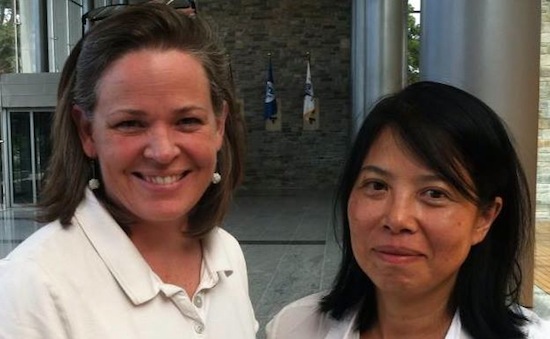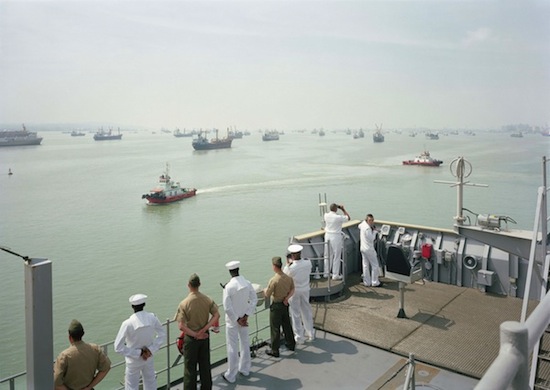An-My Lê creates large format photographs of landscapes altered by military action that merge fact and fiction into nuanced tableaus. The artist came to the United States in 1975 as a refugee of the Vietnam War, and much of her work comes from questioning her own experiences and memories. Currently, An-My Lê is a photography professor at Bard College in Annandale-on-Hudson, NY. In addition, the artist is a 2012 MacArthur Fellow, also known as a ‘Genius Grant,’ which, according to the foundation recognizes “exceptional creativity, promise for important future advances based on a track record of significant accomplishment, and potential for the fellowship to facilitate subsequent creative work” with a $625,000 stipend.
On the eve of the new exhibition Front Room: An-My Lê at the Baltimore Museum of Art and an artist talk at MICA’s Falvey Hall on Saturday, October 12, An-My Lê and BMA Curator Ann Shafer discuss the ideas and challenges behind the exhibit.
Cara Ober: According to the Baltimore Museum, the Front Room An-My Lê exhibit will feature twenty-one large format photographs from four different series. Although all the work depicts the relationship between military forces and landscape, there is a lot of disparity between series – some are black and white, others color, some were shot in post-war Vietnam, while other depict military re-enactors in America, while many others were taken on training, surveillance, and peacekeeping missions around the world. How do these twenty-one photos hold together? What did the selection process entail? And what does the process of choosing works for an exhibit reveal about your work, a curatorial agenda, or your public representation as an artist?
An-My Lê: All this work comes from different projects. Chronologically, Vietnam came first mid 90s to 1997, Small Wars from 1999 or 2000 to 2003, 29 Palms 2003-2005, and Events Ashore 2005 to present. They seem disparate but all stem from the concerns and obsessions I had at different points in my life. Vietnam came about when the US lifted its economic embargo with Vietnam and renewed relations. I traveled back to Vietnam for the first time since my family and I were evacuated in 1975. The pictures have a lot to do with living in exile, dealing with the consequences of war and wanting to reconnect with one’s heritage. I also consciously avoided overt references to war. This is something I explored with Small Wars and working with Vietnam War re-enactors. The invasion of Iraq in 2003 sparked 29 Palms.
Cara Ober (to Ann Shafer): How did you choose to curate and arrange such disparate works into one exhibition? When making decisions on arrangement and inclusion, what issues did you most want to emphasize?
Ann Shafer: An-My Lê’s four series are far from disparate, and in fact make up a very interesting personal journey. They are all facets of the same topic: what is our relationship to the US military, in preparation, in reenactment, in its current state? Lê is approaching the conflicts of the modern age through multilayered images that point toward the contemporary reality of the military industrial complex and she is uniquely qualified to do so. Her personal knowledge and memories of Vietnam during the war give her a potent position to assess its lasting effect. As a political refugee from that country, her return to it years later may not encompass images that are directly about the war, but within them one can find lingering aspects of that conflict. While in that first series, the personal is front and center, but she eventually turned to other aspects. Each series flows naturally from the other and each informs the other.
AS: To answer your question about how we make selections, there are many possible exhibitions to be drawn from with her work (for instance, one could mount an interesting exhibition looking at portraits or the role of women in the military). But for the sake of space, we elected to focus on landscape: both as a character, and as the punctum–the thing that lets you know something isn’t as it seems.
CO: What kind of military clearance do you have to gain to be able to photograph active missions all over the world? Is it difficult to get this type of permission? Have there been places and experiences where you really wanted to go, but have been denied access?
AML: My attempts to become an embed were not successful so I looked into the Marine Corps training in a high desert landscape that resembled parts of Afghanistan or Iraq. Working with the military made me want to explore the entire machinery. It is a huge complex global enterprise that also functions far from front line combat. I have been interested in how the military comes in contact with other cultures, with smaller nations. I have been interested in the support and humanitarian operations, intelligence gathering and propaganda campaigns. There was never a master plan for all these projects but they do come together in interesting ways to speak of war, its memories, the preparations and training for war, the consequences and aftermath of war and of course the entire machinery of war.
CO: There are very few photographers left today working with large format camera. From my own limited experience, I can say that, to me, they have more in common with painting – composition, light, texture, color relationships, patient waiting – than with contemporary photography, which seems more about snapping quickly and editing later. Why do you continue to work with a large format camera? What does it allow you to do or see that a digital or SLR camera does not?
AML: There is something deliberate about working with the camera that may have prompted the connection you made with painting. It is a cumbersome camera that requires you to photograph at rather slow shutter speed. It often forces you to ask people to pose. Even though I have had much luck photographing events unfolding in real time, it is very difficult to capture anything too spontaneous. I believe the quality of the prints, especially the landscapes, I obtain with the help of a 5×7 inch negative gives the viewer a physical experience that also brings this type of photography closer to painting.
CO: Although Lê has travelled across the globe – to Vietnam, to the Persian Gulf, even to Antarctica – to capture different types of military activity, her photos are not photojournalistic. Though she records very specific events and places, the images don’t immediately communicate a single or direct idea. For example, they don’t illustrate facts I might already know from news media. Rather, Lê’s images seem to obfuscate what I think I know about the military. There is a nuance, a distance, and a questioning eye that is more complex and leaves me with more unanswered questions. What do you see as the relationship between Lê’s work and traditional military photojournalism? Do you see this work as contradictory to that genre?
Ann Shafer: Lê’s work has nothing to do with photojournalism. She is not attempting to be photojournalistic nor is she critiquing that branch of photography. Yes, her work and that of war-correspondent photographers share common subjects, but the goals are quite different. Whereas the photojournalist is attempting to capture the one picture that conveys the entire story of a conflict, the photographer is attempting to draw back the curtain on lesser-known aspects of a subject in order to draw viewers in and activate a conversation, not end it with an answer. Lê’s images draw out so many questions and give enough distance from the gory facts of war that we are pulled to seek answers within ourselves about our attitudes toward warfare and the immense presence of the US around the world.
CO: How did you come to choose An-My Lê for the BMA’s Front Room Series? Why do you think her work, in particular, is relevant to a contemporary dialogue about war and the military? What kind of discussion do you hope this work inspires?
AS: First, I believe that art should say something passionately about the topic. This can be done with elegance, restraint, exuberance, or messiness, but good art at the very least will start a conversation. It should make us think about our place in the world as human beings, as men and women, as white, black, Asian, or Latino, as young or old, rich or poor. Human creativity is, after all, the best part of us and is the thing that separates us from the animals. Second, while I hesitate to prescribe answers, I hope visitors feel Lê’s photographs raise questions about our global reality. How do we reconcile the military’s core mission—its responsibility for the country’s defense—with its continued expansion in the realm of scientific exploration, humanitarian missions, and protective services?
CO: What are your personal reactions to this work?
AS: Lê’s photographs are smart and insightful. They give us enough to wonder about the subject, but not enough to dictate our thinking. They make us ask what is happening: are those soldiers really at war or is that North Carolina standing in for Vietnam? In the end, the success of Lê’s photographs lies in her ability to play to both sides of the fence. Not only is she portraying the more mundane side of serving in the military (the monotony combined with a constant state of alertness must be maddening), but also she finds that tipping point between the pro- and anti-war positions leaving room for self-examination.
Front Room: An-My Lê will be on exhibit at the BMA from October 9, 2013 – February 23, 2014.
* Ann Shafer is the Associate Curator of Prints, Drawings, and Photographs at the BMA.
* Cara Ober is the Editor at Bmoreart.








